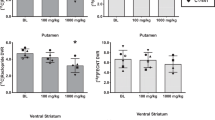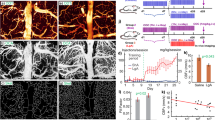Abstract
Rationale: Cerebral blood flow can provide a useful dependent measure to characterize cocaine-induced changes in brain function. The acute effects of cocaine administration on cerebral blood flow may have direct relevance to the etiology of cocaine addiction. Objectives: The present study used positron emission tomography (PET) neuroimaging techniques to characterize the acute effects of cocaine administration on cerebral blood flow in conscious rhesus monkeys. Methods: Functional changes in cerebral blood flow were determined in four drug-naive subjects with the positron-emitting tracer 15O water following acute i.v. administration of cocaine (0.3 and 1.0 mg/kg). Specific attention was devoted to the development of an effective and comfortable head restraint device to use in the imaging of conscious monkeys. Experimental sessions comprised eight consecutive i.v. injections of 15O water at 10-min intervals. PET scans of 90 s duration occurred 10 s after each injection. Results: Repeated baseline determinations of cerebral blood flow prior to drug administration were reliable. Cocaine had significant, dose-related effects on cerebral blood flow at 5 min postinjection that diminished relative to control (saline) conditions by 15 min postinjection. Brain activation maps normalized to global flow showed prominent cocaine-induced activation of prefrontal cortex localized primarily to dorsolateral regions. Importantly, cocaine-induced brain activation was blocked by pretreatment with the selective serotonin uptake inhibitor, alaproclate (3.0 and 10.0 mg/kg). The results document a distinct pattern of cocaine-induced brain activation that is sensitive to pharmacological manipulation. Conclusion: The pattern of brain activation induced by acute administration of cocaine may provide a useful means to evaluate medication effectiveness for treating cocaine addiction.
Similar content being viewed by others
Author information
Authors and Affiliations
Additional information
Electronic Publication
Rights and permissions
About this article
Cite this article
Howell, L.L., Hoffman, J.M., Votaw, J.R. et al. Cocaine-induced brain activation determined by positron emission tomography neuroimaging in conscious rhesus monkeys. Psychopharmacology 159, 154–160 (2002). https://doi.org/10.1007/s002130100911
Received:
Accepted:
Published:
Issue Date:
DOI: https://doi.org/10.1007/s002130100911




